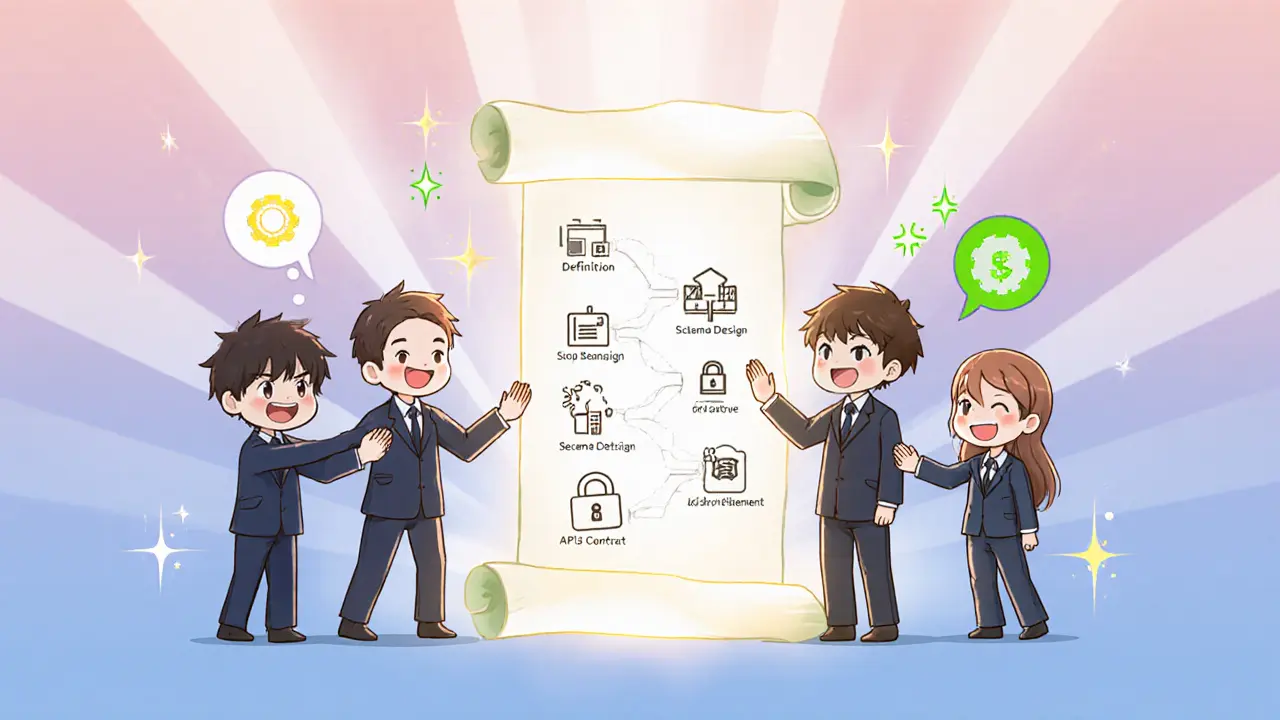Interoperability Standards Selector
This interactive tool helps you select the right interoperability standards for your project based on domain, data format preferences, and integration requirements.
Recommended Standards
How This Works
Based on your selections, we recommend the most suitable interoperability standards for your use case. Each recommendation includes:
- The standard name and domain
- Primary data format(s)
- Typical use case
- Key benefits for your scenario
Ever tried to connect two software systems only to find they can’t ‘talk’ to each other? That frustration is the exact problem interoperability solves. Whether you’re moving patient records between hospitals, syncing inventory across continents, or enabling a mobile payment app to talk to a banking back‑end, the right protocols and standards make it happen without endless custom code.
Quick Takeaways
- Interoperability spans four levels - from simple data exchange to full organizational alignment.
- XML and JSON are the most common data‑format standards; APIs are the glue that binds them.
- Industry‑specific standards (HL7, FHIR, EDIFACT, OData, PCIDSS) provide ready‑made vocabularies and rules.
- Governance, policy and legal frameworks are the final piece that lets different parties trust each other.
- Use the checklist below to pick the right standard for your project and avoid common pitfalls.
What is Interoperability?
Interoperability is a system’s ability to work seamlessly with other systems, exchanging data, services, or workflows without extra translation layers. The concept has grown from a purely technical definition to include social, legal, and organizational dimensions.
Four maturity levels help you assess where a solution sits:
- Foundational (Level1): Simple data push/pull - e.g., sending a CSV file.
- Structural (Level2): Common syntax and formats (XML, JSON) that preserve meaning at the field level.
- Semantic (Level3): Shared vocabularies and models so the receiving system knows exactly what the data represent.
- Organizational (Level4): Agreements on policies, trust frameworks, and legal responsibilities.
Skipping any level often leads to “data silos” or costly integration projects.
Core Data Formats and Communication Protocols
At the heart of modern interoperability are two lightweight, human‑readable formats:
- XML (Extensible Markup Language) - a hierarchical, tag‑based format that has been the workhorse for enterprise data exchange since the late 1990s. It excels where strict schema validation is required, such as in financial reporting.
- JSON (JavaScript Object Notation) - a lighter, key‑value based format favored by web and mobile apps for its speed and ease of parsing. Most modern APIs deliver JSON payloads.
Both formats rely on a shared character encoding (usually UTF‑8) to ensure syntactic interoperability across platforms.
SQL is often mentioned as a “protocol” because the language defines how systems query relational data stores. When two applications agree on a common schema, they can exchange data directly via SQL over ODBC/JDBC connections.
APIs: The Integration Gateway
API (Application Programming Interface) acts as a contract that describes how software components should interact. An API specification (like OpenAPI or GraphQL) lists endpoints, request/response formats, authentication methods, and error codes.
Developers build their solutions against these contracts instead of hand‑crafting adapters for each partner system. This approach reduces code duplication and makes upgrades predictable. When an API follows a recognized standard-say, RESTful HTTP with JSON bodies-you instantly gain structural and semantic interoperability with any client that respects the same conventions.

Industry‑Specific Standards
Many sectors have already codified the vocabularies, data models, and security rules needed for smooth exchange. Below is a quick snapshot of the most widely adopted standards.
| Standard | Domain | Primary Data Format | Typical Use Case | First Released |
|---|---|---|---|---|
| HL7 Health Level Seven - legacy messaging standard for clinical data | Healthcare | XML | Hospital information system exchange | 1987 |
| FHIR Fast Healthcare Interoperability Resources - modern, REST‑based HL7 successor | Healthcare | JSON / XML | Mobile health apps accessing EHR data | 2014 |
| EDIFACT Electronic Data Interchange for Administration, Commerce, and Transport - global trade messaging | Logistics & Trade | ASCII‑based segment format | Purchase orders, invoices across borders | 1987 |
| OData Open Data Protocol - standardized query language for REST services | Enterprise Data Integration | JSON / AtomPub | Exposing database queries as web services | 2007 |
| PCI DSS Payment Card Industry Data Security Standard - security framework for card transactions | Payments | Various (XML, JSON, proprietary) | Secure credit‑card processing | 2004 |
Each of these standards encodes not only the data format but also a shared vocabulary (e.g., medical codes in HL7/FHIR, product codes in EDIFACT). Implementing any of them automatically lifts you to at least structural, often semantic, interoperability within that domain.
Governance, Policy, and Organizational Alignment
Technical glue alone isn’t enough. The International Telecommunication Union’s ITU‑T (ITU Telecommunication Standardization Sector) defines global telecom protocols, frequency allocations, and signaling standards exemplifies how governments and industry groups cooperate to set rules that all participants must obey.
At Level4, organizations sign data‑sharing agreements, define privacy policies, and adopt trust frameworks. Without these, even perfectly formatted messages can be blocked by compliance teams or legal departments.
Choosing the Right Standards - A Practical Checklist
- Identify the business domain. Health, finance, logistics, or public sector each have mature standards.
- Map data exchange frequency. Real‑time APIs favour JSON/REST; batch processes can tolerate EDIFACT or XML.
- Assess regulatory requirements. PCI DSS for payments, GDPR for personal data, HIPAA for health.
- Check ecosystem support. Does your vendor ecosystem already ship libraries for the standard?
- Plan for versioning. Choose standards with clear upgrade paths (e.g., FHIR R4 → R5).
- Evaluate governance overhead. Organizational interoperability can demand legal contracts and audit processes.
Following this list helps you avoid the classic “plug‑and‑play” disappointment where a standard looks perfect on paper but collides with real‑world constraints.
Common Pitfalls and Pro Tips
- Pitfall: Assuming “JSON works everywhere.” Tip: Validate schemas (JSON Schema) and enforce strict content‑type headers.
- Pitfall: Ignoring character encoding. Tip: Always declare UTF‑8 and test with non‑ASCII characters.
- Pitfall: Over‑relying on vendor‑specific extensions. Tip: Stick to the core standard; extensions should be optional and documented.
- Pitfall: Skipping security in the name of speed. Tip: Use TLS, mutual authentication, and token‑based auth (OAuth 2.0) for all API exchanges.
- Pitfall: Forgetting governance. Tip: Draft a simple data‑sharing agreement early; it saves weeks of negotiation later.
Putting It All Together - A Mini‑Implementation Blueprint
- Define the integration scope and classify the required interoperability level.
- Select the industry‑standard that matches the domain (e.g., FHIR for health).
- Choose the data format (JSON for REST, XML for legacy SOAP) and generate a schema.
- Publish an API contract (OpenAPI spec) that references the chosen schema.
- Implement authentication, logging, and monitoring per the governance checklist.
- Run an end‑to‑end test suite - include positive, negative, and security test cases.
- Document the legal agreements, versioning strategy, and support contacts.
When each step aligns, you’ll have moved from simple data exchange to a robust, trustworthy network of systems that can scale with your business.

Frequently Asked Questions
What is the difference between XML and JSON for interoperability?
XML offers richer schema validation (XSD) and namespace support, making it ideal for complex, regulated industries like finance or healthcare. JSON is lighter, easier to read, and faster to parse, which suits web‑centric, real‑time APIs. Choose XML when strict validation is a must; pick JSON for speed and developer friendliness.
How does semantic interoperability differ from structural interoperability?
Structural interoperability guarantees that data arrives in a consistent format (e.g., the same XML tags). Semantic interoperability adds a shared meaning layer - both parties agree on what each tag represents, often through standard vocabularies like SNOMED CT for health or UN/CEFACT codes for trade.
Can I mix standards, like using OData with HL7 messages?
Yes, but you need a translation layer that maps OData queries to HL7 payloads. This is common in hybrid environments where a modern web portal consumes legacy hospital data via an OData wrapper that internally converts to HL7/FHIR.
What governance steps are essential for organizational interoperability?
Key steps include drafting data‑sharing agreements, defining privacy and security policies, establishing a joint steering committee, and setting up audit trails. Aligning on a common trust framework (e.g., ISO27001) helps all parties feel secure.
Where can I find up‑to‑date versions of these standards?
Official bodies host them: HL7.org for HL7/FHIR, UN/CEFACT for EDIFACT, OASIS for OData, PCI Security Standards Council for PCI DSS, and the ITU‑T website for telecom protocols. Many also provide free implementation guides.




Briana Holtsnider
February 27, 2025 AT 05:40Your so‑called “practical guide” reads like a marketing brochure, full of buzzwords and thin explanations. The code snippets are hidden behind a UI that does nothing but look pretty. You claim to solve real‑time integration headaches, yet you never mention versioning or backward compatibility. The checklist at the end feels tacked on, as if you needed to throw something substantive in. In short, it’s more fluff than substance.
Corrie Moxon
February 27, 2025 AT 06:46I appreciate the effort you put into pulling all those standards together. It’s a solid starting point for teams that feel overwhelmed by the sheer number of options. Highlighting the governance layer is especially useful, because many folks ignore that until it hits them later. Your checklist will definitely keep people from missing the obvious.
Jeff Carson
February 27, 2025 AT 07:53When you’re working with OData, remember that the $metadata endpoint can save you hours of manual schema mapping 😊. It’s also worth noting that you can combine OData with FHIR resources for hybrid health‑logistics solutions, which many don’t think about. The JSON‑first approach in modern APIs is solid, but keep an eye on the "Accept" header to avoid accidental XML returns. A quick test with Postman can verify that the service respects content negotiation.
Don’t forget to enable CORS if you plan to call the API from a browser.
Anne Zaya
February 27, 2025 AT 09:00I love the color scheme on the selector.
Emma Szabo
February 27, 2025 AT 10:06What a vibrant tour through the maze of interoperability! Your breakdown of XML versus JSON feels like a splash of fresh paint on a stale canvas. I especially dig the way you tie each industry standard to its real‑world use case – it makes the abstract concrete. The section on governance reads like a gentle reminder that tech alone won’t cut it without policy; kudos for that nuance. Your checklist at the end is the cherry on top, guiding readers step‑by‑step. The tone is upbeat yet informative, striking the right balance. I can picture a dev team using this as a cheat‑sheet during sprint planning. Bonus points for mentioning character encoding – that’s often overlooked! Overall, this guide could be the go‑to reference for anyone wading into the interoperability swamp.
Fiona Lam
February 27, 2025 AT 11:13This guide tries to be everything and ends up being nothing. The “interactive tool” feels like a half‑baked demo that you’d see on a busted conference booth. If you wanted to actually help people, ditch the glossy UI and give us raw, actionable steps. As it stands, it’s just a pretty brochure.
OLAOLUWAPO SANDA
February 27, 2025 AT 12:20All these standards sound like a Western invention, but we have our own ways back home. Don’t pretend one size fits all when the context is different.
Alex Yepes
February 27, 2025 AT 13:26Let us consider a systematic blueprint for implementing interoperability in a mid‑size enterprise. First, conduct a thorough domain analysis to pinpoint the exact data exchange scenarios that drive business value. Second, map each scenario to the appropriate maturity level, ensuring that foundational data pushes are upgraded to structural or semantic layers as needed. Third, select a domain‑specific standard – for instance, FHIR for health or OData for enterprise data – and obtain its latest version documentation. Fourth, generate a formal schema using JSON Schema or XSD, applying strict validation rules to eliminate ambiguous payloads. Fifth, publish an OpenAPI contract that references the schema, defining each endpoint, method, request, and response in detail. Sixth, implement robust authentication mechanisms such as OAuth 2.0 with scopes that mirror the data sensitivity requirements. Seventh, enforce transport security with TLS 1.3 and consider mutual TLS for high‑risk interactions. Eighth, embed comprehensive logging and monitoring hooks that capture request IDs, latency, and error codes for auditability. Ninth, construct a test harness that runs positive, negative, and security test cases on each API version, automating regression checks in CI/CD pipelines. Tenth, draft legal data‑sharing agreements that align with regulatory frameworks like HIPAA, GDPR, or PCI DSS, and circulate them among all stakeholder parties. Eleventh, establish a governance board that meets quarterly to review version upgrades, deprecation plans, and policy compliance. Twelfth, provide developer documentation that is both human‑readable and machine‑parseable, including example payloads and error handling guides. Thirteenth, train operational staff on the governance processes and the technical nuances of the selected standard. Fourteenth, roll out the integration in phases, starting with a pilot environment before scaling to production. Fifteenth, collect performance metrics and stakeholder feedback to iteratively refine the integration. Sixteenth, maintain a versioning strategy that uses semantic versioning, ensuring backward compatibility whenever possible. Seventeenth, regularly audit security controls and conduct penetration testing to uncover potential vulnerabilities. Eighteenth, finally, celebrate the successful deployment, but remain vigilant; interoperability is a living ecosystem that requires continuous stewardship.
Sumedha Nag
February 27, 2025 AT 14:33I’m not sold on the hype around “one‑stop” standards. Every time you pick one, you end up chasing another edge case.
Holly Harrar
February 27, 2025 AT 15:40Hey there! This guide is really helpful, I’m definitely gonna try the checklist on my next project. The part about character encoding is super important – I actually had a bug because of a missing UTF‑8 header before. Also, the way you broke down the levels makes it easy to explain to the non‑tech folks. I wish there was a bit more on versioning, but overall it’s great.
Vijay Kumar
February 27, 2025 AT 16:46Good overview, but remember that real‑world deployments often hit hidden snags. For example, legacy SOAP services sometimes refuse JSON payloads even when the spec says they should accept them. Also, network latency can become a show‑stopper for real‑time APIs if you don’t design proper back‑pressure handling. Keep an eye on error handling strategies, especially with retries – you don’t want to flood a downstream system. Finally, make sure your governance docs are versioned alongside your APIs to avoid confusion later.
Edgardo Rodriguez
February 27, 2025 AT 17:53Regarding the extensive blueprint you presented, it is worth noting, however, that the order of steps matters; initiating governance before technical implementation can prevent rework, and aligning schema validation early, indeed, streamlines downstream testing, which saves resources, ultimately fostering smoother integration cycles.
mudassir khan
February 27, 2025 AT 19:00The critique of the UI is valid; however, the content itself, when isolated, does provide value. The emphasis on TLS and OAuth, for instance, aligns with current security best practices, and that is commendable. Yet, the presentation could be more professional, and the language refined, to match the seriousness of the topic.
Bianca Giagante
February 27, 2025 AT 20:06While the security points are well‑made, the tone of the previous comment seemed overly harsh; a balanced approach encourages collaboration and fosters constructive dialogue.
Andrew Else
February 27, 2025 AT 21:13Sure, another guide about standards. Because that's what the world needed right now.
Susan Brindle Kerr
February 27, 2025 AT 22:20Honestly, this reads like a pretentious lecture from someone who never got their hands dirty. The language is florid, the examples are generic, and the practical advice is scarce. If you want credibility, show some real‑world case studies.
Jared Carline
February 27, 2025 AT 23:26The guide attempts to be comprehensive, yet it omits the crucial perspective of emerging economies, where standards adoption is hindered by infrastructure constraints. One must consider the socio‑economic context when advocating for universal protocols, otherwise the recommendations remain elitist.
raghavan veera
February 28, 2025 AT 00:33Interoperability isn’t just about code; it’s about shared understanding. When different systems speak, they also need to listen, and that requires patience more than just technical specifications.